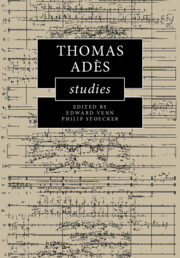Book contents
- Thomas Adès Studies
- Thomas Adès Studies
- Copyright page
- Dedication
- Contents
- Figures
- Tables
- Music Examples
- Online Materials
- Contributors
- Preface
- Acknowledgements
- Notes on the Text
- 1 ‘Chronically volatile’
- 2 Performing Adès
- 3 ‘Fountain of Youth’, ‘River of Meaning’
- 4 ‘Oh brave new Caliban’
- 5 Chaconnes in the Music of Adès
- 6 Closing the Circle?
- 7 A World in Constant Motion
- 8 Musique automatique? Adèsian Automata and the Logic of Disjuncture
- 9 Narrating the Dance of Death
- 10 Hearing Voices in Adès’s Operas
- 11 The RICH Logic of Adès’s The Exterminating Angel and The Tempest
- 12 Sonic Allegory in Adès’s The Exterminating Angel
- Bibliography
- Index
11 - The RICH Logic of Adès’s The Exterminating Angel and The Tempest
Published online by Cambridge University Press: 18 November 2021
- Thomas Adès Studies
- Thomas Adès Studies
- Copyright page
- Dedication
- Contents
- Figures
- Tables
- Music Examples
- Online Materials
- Contributors
- Preface
- Acknowledgements
- Notes on the Text
- 1 ‘Chronically volatile’
- 2 Performing Adès
- 3 ‘Fountain of Youth’, ‘River of Meaning’
- 4 ‘Oh brave new Caliban’
- 5 Chaconnes in the Music of Adès
- 6 Closing the Circle?
- 7 A World in Constant Motion
- 8 Musique automatique? Adèsian Automata and the Logic of Disjuncture
- 9 Narrating the Dance of Death
- 10 Hearing Voices in Adès’s Operas
- 11 The RICH Logic of Adès’s The Exterminating Angel and The Tempest
- 12 Sonic Allegory in Adès’s The Exterminating Angel
- Bibliography
- Index
Summary
Thomas Adès described his compositions as the ‘organic, necessary’ linking of ‘tiny cells’ into larger structures by a ‘musical logic.’ This chapter demonstrates how successions of dyads in his two recent operas follow the logic of a specific musical transformation, retrograde-inversion chaining. This distinctively temporal process establishes cyclical patterns which can be realised, twisted or broken in various dramatic situations. In The Tempest, the cycles direct the music in ways that express Prospero’s power and Caliban’s resistance. Such logic, applied to different materials, also permeates The Exterminating Angel. On the surface, the retrograde-inversion chains represent the dissipation of the characters’ will. More deeply, though, the logic underwrites the tonality and form in the Act I lovers’ duet, the ‘Fugue of Panic’ and Leticia’s creative exuberance at a pivotal dramatic moment. These observations offer insight into how Adès controls musical time on the very largest scale.
Keywords
- Type
- Chapter
- Information
- Thomas Adès Studies , pp. 233 - 257Publisher: Cambridge University PressPrint publication year: 2021

